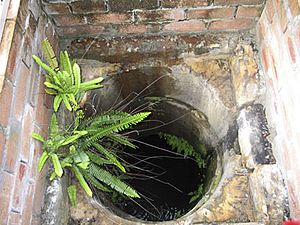Underground Grain Silos facts for kids
Quick facts for kids Underground Grain Silos |
|
|---|---|

Mouth of one of the silos, 2006
|
|
| Location | Cockatoo Island, Sydney Harbour, New South Wales, Australia |
| Official name: Underground Grain Silos | |
| Type | Listed place (Historic) |
| Designated | 22 June 2004 |
| Reference no. | 105264 |
| Lua error in Module:Location_map at line 420: attempt to index field 'wikibase' (a nil value). | |
The Underground Grain Silos are old storage pits located on Cockatoo Island in Sydney Harbour, Australia. These special silos are listed as a heritage site. This means they are important to Australia's history and are protected. They were added to the Australian Commonwealth Heritage List on 22 June 2004.
Contents
A Look Back: History of the Silos
Cockatoo Island became a prison, called a gaol, in 1839. This happened after the Governor of New South Wales, George Gipps, suggested it. Convicts were sent there after another prison on Norfolk Island closed.
The convicts built many things on the island. One of their first jobs was digging these grain silos. They also helped build the Fitzroy Dock, a large dry dock for ships. This dock was finished in 1857. Cockatoo Island then became a very important place for building and fixing ships in Australia.
In 1869, the prisoners left the island. The prison buildings were then used as a school for girls and a reformatory from 1871. Later, in 1888, prisoners returned to the island. The prison stayed open until about 1909. Meanwhile, the dockyard grew even bigger. The Sutherland Dock was built in 1890. Cockatoo Island was known as the state's main dockyard.
After Australia became a federation in 1913, Cockatoo Island became the Commonwealth Dockyard. It played a big role in building ships for the Royal Australian Navy. It was also very important during the First World War. The old prison buildings were used as offices. From 1933, a company called Cockatoo Docks & Engineering leased the dockyard. The island was crucial during the Second World War. After the war, the dockyard continued to operate. It even added facilities for submarines. The dockyard finally closed in 1992. Today, the island is managed by the Sydney Harbour Federation Trust.
Why Were the Silos Built?
In the early days of the colony, getting enough food was a challenge. Governor Gipps decided in 1839 to build silos on Cockatoo Island. This would allow them to store grain for future use.
The silos were designed by Colonel George Barney, a key engineer in the colony. Convicts dug them out of the island's sandstone rock. They were sealed very well, which meant tiny bugs called weevils couldn't get in. By November 1840, the completed silos held 20,000 bushels of wheat. More silos were being built. Governor Gipps hoped to store up to 100,000 bushels.
However, Britain later changed its policies. They wanted a free market, not the government storing grain. So, Governor Gipps was told to sell the grain. Later, in the 1870s or early 1880s, the silos were used to store water instead. Some silos were destroyed when new buildings were constructed. The silos still on the island are special. They are believed to be the only group of rock silos dug by convicts in Australia. Another group of convict-built silos is on Norfolk Island, but those are dug into the earth.
What the Silos Look Like
The Underground Grain Silos are located on the top of Cockatoo Island. They are about 65 meters south-east of a building called Biloela. They are between a cottage and the cliff.
This group of silos has three complete ones and two half ones. The two half silos were cut during construction work in the Second World War. The silos are shaped like a bottle and are perfectly round. On the surface of the rock, you can see a mark showing how wide the silo is underground. The opening at the top is square. It has a lip to keep water out and a metal plate covering it. The "bottle" part is circular and almost 5.5 meters wide. Each silo could hold between 3,000 and 5,000 bushels of grain. You can still see thirteen silos on the island today. Other silos are located near Biloela House.
Condition of the Silos
As of May 2001, the silos that are still complete are in good condition.
Why They Are Heritage Listed
The Underground Grain Silos were added to the Australian Commonwealth Heritage List on 22 June 2004. They met several important criteria:
- Criterion A: How They Were Used
* Dug in 1839-40, these silos are very important because they show us about the convict era in New South Wales. * They were also used to store water later. This connects them to other times in Cockatoo Island's history. These times include when it was a school and a major government shipyard. * The silos also tell us about how food was supplied and how the government worked in the early days of the colony.
- Criterion B: How Rare They Are
* The silos on Cockatoo Island are thought to be the only large group of rock silos dug by convicts in Australia. This makes them very rare.
- Criterion F: Technical Skill
* The silos were dug out very carefully and precisely. This shows the amazing stonemasonry skills of the people who built them.
- Criterion H: Important People
* The silos are also important because they are linked to Colonel George Barney. He was a very important engineer in colonial New South Wales for many years.

